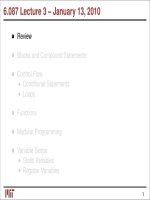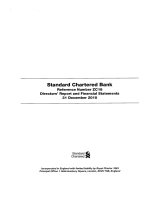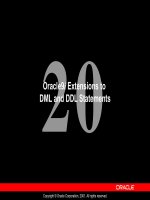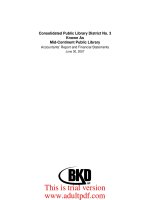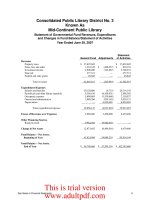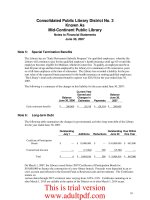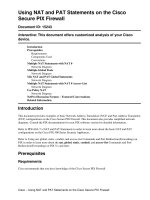Blocks and compound statements
Bạn đang xem bản rút gọn của tài liệu. Xem và tải ngay bản đầy đủ của tài liệu tại đây (299.29 KB, 51 trang )
6.087 Lecture 3 – January 13, 2010
Review
Blocks and Compound Statements
Control Flow
Conditional Statements
Loops
Functions
Modular Programming
Variable Scope
Static Variables
Register Variables
1
Review: Definitions
•
Variable - name/reference to a stored value (usually in
memory)
•
Data type - determines the size of a variable in memory,
what values it can take on, what operations are allowed
•
Operator - an operation performed using 1-3 variables
•
Expression - combination of literal values/variables and
operators/functions
1
Review: Data types
•
Various sizes (
char
,
short
,
long
,
float
,
double
)
•
Numeric types -
signed
/
unsigned
•
Implementation - little or big endian
•
Careful mixing and converting (casting) types
2
Review: Operators
•
Unary, binary, ternary (1-3 arguments)
•
Arithmetic operators, relational operators, binary (bitwise
and logical) operators, assignment operators, etc.
•
Conditional expressions
•
Order of evaluation (precedence, direction)
3
6.087 Lecture 3 – January 13, 2010
Review
Blocks and Compound Statements
Control Flow
Conditional Statements
Loops
Functions
Modular Programming
Variable Scope
Static Variables
Register Variables
4
Blocks and compound statements
•
A simple statement ends in a semicolon:
z = foo(x+y);
•
Consider the multiple statements:
temp = x+y ;
z = foo ( temp ) ;
•
Curly braces – combine into compound statement/block
4
Blocks
•
Block can substitute for simple statement
•
Compiled as a single unit
Variables can be declared inside
•
{
i n t temp = x+y ;
z = foo ( temp ) ;
}
•
Block can be empty {}
No semicolon at end
•
5
Nested blocks
Blocks nested inside each other
•
{
i n t temp = x+y ;
z = foo ( temp ) ;
{
f l o a t temp2 = x ∗y ;
z += bar ( temp2 ) ;
}
}
6
6.087 Lecture 3 – January 13, 2010
Review
Blocks and Compound Statements
Control Flow
Conditional Statements
Loops
Functions
Modular Programming
Variable Scope
Static Variables
Register Variables
7
Control conditions
•
Unlike C++ or Java, no boolean type (in C89/C90)
•
in C99,
bool
type available (use stdbool.h)
•
Condition is an expression (or series of expressions)
e.g.
n < 3
or
x < y || z < y
Expression is non-zero condition true
•
⇒
•
Expression must be numeric (or a pointer)
const char s t r [ ] = "some text" ;
i f ( s t r ) /
∗ s t r i n g i s not n u l l ∗ /
retu rn 0;
7
Conditional statements
The if statement
•
The switch statement
•
8
The if statement
i f ( x % 2)
y += x / 2 ;
Evaluate condition
•
if (x % 2 == 0)
•
If true, evaluate inner statement
y += x/2;
•
Otherwise, do nothing
9
The else keyword
i f ( x % 2 == 0)
y += x / 2 ;
else
y += ( x + 1 ) / 2 ;
•
Optional
Execute statement if condition is false
•
y += (x+1)/2;
•
Either inner statement may be block
10
The else if keyword
i f ( x % 2 == 0)
y += x / 2 ;
else i f ( x % 4 == 1)
y += 2
∗ ( ( x + 3 ) / 4 ) ;
else
y += ( x + 1 ) / 2 ;
•
Additional alternative control paths
•
Conditions evaluated in order until one is met; inner
statement then executed
•
If multiple conditions true, only first executed
•
Equivalent to nested if statements
11
Nesting if statements
i f ( x % 4 == 0)
i f ( x % 2 == 0)
y = 2 ;
else
y = 1 ;
To which if statement does the else keyword belong?
12
Nesting if statements
To associate else with outer if statement: use braces
i f ( x % 4 == 0) {
i f ( x % 2 == 0)
y = 2 ;
} else
y = 1 ;
13
The switch statement
Alternative conditional statement
•
•
Integer (or character) variable as input
Considers cases for value of variable
•
switch ( ch ) {
case ’Y’ : /
∗ ch == ’Y ’ ∗ /
/
∗ do something ∗ /
break ;
case ’N’ : /
∗ ch == ’N ’ ∗ /
/
∗ do something e l se ∗ /
break ;
de f a ul t : /
∗ o t h er w is e ∗ /
/
∗ do a t h i r d t h i n g ∗ /
break ;
}
14
Multiple cases
•
Compares variable to each case in order
•
When match found, starts executing inner code until
break; reached
•
Execution “falls through” if break; not included
switch ( ch ) {
switch ( ch ) { case ’Y’ :
case ’Y’ : /
∗ do something i f
case ’y’ : ch == ’Y ’
∗ /
/ ∗ do something i f case ’N’ :
ch == ’Y ’ or /
∗ do something i f
ch == ’ y ’
∗ / ch == ’Y ’ or
break ; ch == ’N ’ ∗ /
} break ;
}
15
The switch statement
Contents of switch statement a block
•
•
Case labels: different entry points into block
•
Similar to labels used with goto keyword (next lecture. . . )
16
Loop statements
•
The while loop
•
The for loop
•
The do-while loop
•
The break and continue keywords
17
The while loop
while ( / ∗ c o n d i t i o n ∗ / )
/
∗ l oop body ∗ /
•
Simplest loop structure – evaluate body as long as
condition is true
•
Condition evaluated first, so body may never be executed
18
The for loop
i n t f a c t o r i a l ( i n t n ) {
i n t i , j = 1 ;
fo r ( i = 1 ; i <= n ; i ++)
j ∗= i ;
retu rn j ;
}
•
The “counting” loop
•
Inside parentheses, three expressions, separated by
semicolons:
Initialization: i = 1
•
Condition: i <= n
•
Increment: i++
•
•
Expressions can be empty (condition assumed to be “true”)
19
The for loop
Equivalent to while loop:
i n t f a c t o r i a l ( i n t n ) {
i n t j = 1 ;
i n t i = 1 ; /
∗ i n i t i a l i z a t i o n ∗ /
while ( i <= n /
∗ c o n d i t i o n ∗ / ) {
j ∗= i ;
i ++; / ∗ i ncr e men t ∗ /
}
retu rn j ;
}
20
The for loop
•
Compound expressions separated by commas
i n t f a c t o r i a l ( i n t n ) {
i n t i , j ;
fo r ( i = 1 , j = 1 ; i <= n ; j ∗= i , i ++)
;
retu rn j ;
}
•
Comma: operator with lowest precedence, evaluated
left-to-right; not same as between function arguments
21
The do-while loop
char c ;
do {
/ ∗ l oop body ∗ /
puts ( "Keep going? (y/n) " ) ;
c = ge tc ha r ( ) ;
/ ∗ o t h e r p ro ce s si ng ∗ /
} while ( c == ’y’ && /
∗ o t h e r c o n d i t i o n s ∗ / ) ;
•
Differs from while loop – condition evaluated after each
iteration
•
Body executed at least once
Note semicolon at end
•
22
